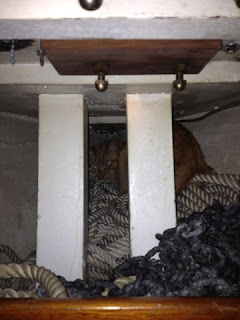 |
| Dana filling the drill holes in the now-bare transom. |
I've joked for a while now that my boat has 3 names: Salvia, the old name; Ardea, the new name; and Saliva, the typo on the registration certificate. I'm pretty excited to finally have it down to just one. We gave Salvia a good last hurrah this weekend, though. Dana and I sailed for about 8 hours on Saturday and accomplished a couple of firsts.
We road a 5 knot ebb out the Gate and got her out on the glorious Pacific for the first time since her move to the Bay!
We also had the most substantial night sail since I've owned the boat, which included plenty of commercial traffic. Though always scary to be sailing around ships you must assume do not know you are there, it was nice to have vindication for installing an AIS receiver. It was super useful to be able to see commercial traffic on the plotter screen- it's remarkably difficult to pick out ships' lights against the urban background and they move so quickly that before you've decided whether they belong to Ghiradelli Square or Alcatraz or one of the bridges, those lights and the millions of tons of steel they're attached to can be right on top of you.
We also gave the engine (Perkins 4.107 diesel) it's most significant run since I've owned the boat. Most of the time I run the engine for about ten minutes total getting into and out of the slip (we're spoiled with wind on the Bay). However, the wind died Saturday evening and we were still 2 miles outside the Gate at sunset, so after a couple hours of very slow progress, we fired up the Perkins. I think we kept it up near 2000 rpms for a little less than two hours without a hiccup and made 6 knots. I was happy to give the engine that test and even happier to have it perform well.
Then, Sunday, my parents came out for their first sail on the boat along with my uncle Tom and cousin Henry. We even brought Milo, the snaggle-tooth cat, along for the ride; he crawled all the way forward to the anchor locker and took a series of naps on the rode, puncuated by our tacking. More beautiful autumn weather, family and friends were a great last hurrah for the boat named Saliva. This week, I'll finish getting the new name and port-of-call put on the transom and we'll be that much closer. Though mindful of superstitions, I am excited for the new era of Ardea.
 |
| Milo, otherwise known as Snaggle-tooth. |


























